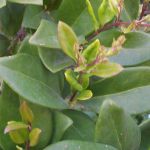| Common Name: |
Chinese Privet |
| Other Names: |
Glossy Privet |
| Botanical Name: |
Ligustrum lucidum |
| Genus: |
Ligustrum |
| Family: |
Oleaceae |
| Location: |
China, Japan, Korea. |
| Cultivation: |
Well-drained soil in sun or shade. Variegated cultivars are best in sun. |
| Propagation: |
By seed sown in winter (species only); by semi-ripe cutting in summer, by hardwood cuttings in winter. Leaf spot may damage leaves. |
| Harvest: |
Fruits are collected when ripe, and dried, then usually mixed with honey and steamed before further drying for use in decoctions, powders, and pills. |
| Warning: |
Harmful if eaten |
| Height: |
10m (3ft) |
| Width: |
10m (3ft) |
| Variations: |
Excelsum Superbum
Has yellow-edged, bright green leaves with pale green markings. |
Tricolor
Has narrow leaves, variegated gray-green, with white margins, pink-flushed when young. |
|
| Hardiness: |
Z7-10 |
| Parts Used: |
Berries |
| Properties: |
A bitter, slightly sweet herb that acts as a tonic for the kidneys and liver. It has diuretic, anti-tumor, anti-bacterial, and possibly anti-viral effects. |
| Medicinal Uses: |
Internally for complaints associated with weak kidney and liver energy, such as menopausal problems, (especially premature menopause), blurred vision, cataracts, tinnitus, graying of hair, rheumatic pains, palpitations, backache, and insomnia. |
| Bibliography: |
Encylopedia of Herbs by Deni Brown Copyright ©: 1995, 2001 Dorling Kindersley Limited pp 261-262
|
